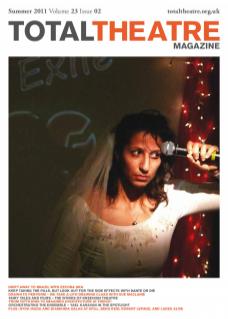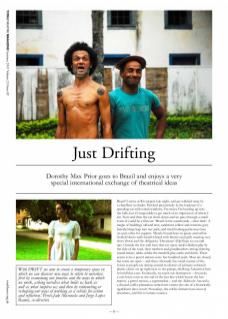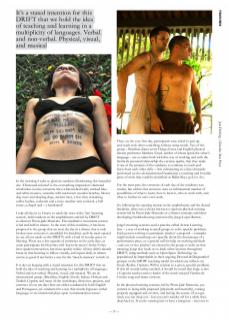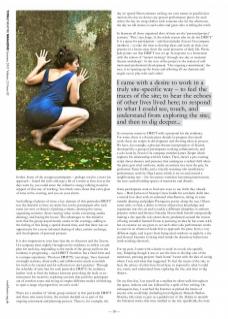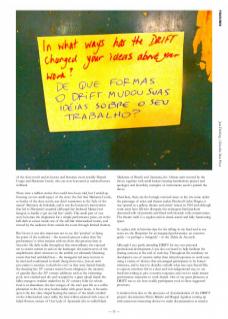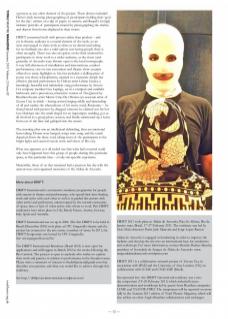‘With DRIFT we aim to create a temporary space in which we can discover new ways to relate to ourselves: first by examining our practice and the ways in which we work, asking ourselves what holds us back as well as what inspires us; and then by reinventing or reshaping our ways of working as a vehicle for action and reflection.’ Persis-Jade Maravala and Jorge Lopes Ramos, co-directors
Brazil! I arrive at Rio airport late night, and get whisked away by a chauffeur in shades. Perched precariously in the backseat of a speeding car with tinted windows, I’m aware I’m heading up into the hills, but it’s impossible to get much of an impression of where I am. Now and then the car slows down and we pass through a small town. It could be a film set: ‘Brazil in the countryside – after dark’. A tangle of buildings old and new, sandstone yellow and concrete grey. Suicidal dogs leap into our path, and tired-looking palm trees lean on each other for support. Muscle-bound boys in green-and-yellow football shirts walk hand-in-hand with brown-eyed girls wearing very short shorts and the obligatory ‘Havaianas’ (flip-flops to you and me). Outside the few café-bars that are open, small children play by the side of the road, their mothers and grandmothers sitting chatting round rickety tables whilst the menfolk play cards and drink. There seems to be a petrol station every few hundred yards. Most are closed, but some are open – and these obviously the social centres of the towns as people are sitting around in clusters of primary-coloured plastic chairs set up right next to the pumps, drinking Antarctica beer in lurid blue cans. Eventually, we reach our destination – Arcozelo, a one-horse town at the end of the bus line which boasts the bus station, a petrol station, a supermarket – and the Aldeia de Arcozelo, a disused coffee plantation turned arts centre; the site of a historically significant slave revolt. Nowadays, the coffee farmers have moved elsewhere, and this is tomato country.
In the morning I wake to glorious sunshine illuminating this beautiful site. ‘Distressed colonial’ is the overarching impression: shuttered windowless rooms; terracotta tiles; whitewashed walls; cracked blueand-white mosaics, verandas with nut-brown wooden benches, blowsy dog roses and sleeping dogs, ancient trees, a few stray remaining coffee bushes, cockerels and a rusty weather-vain cockerel, a bell tower, a chapel and – a bandstand!
I take all this in as I hurry to catch the start of the 7am ‘morning session’, held outdoors in the amphitheatre and led by DRIFT co-director Persis-Jade Maravala. This meditative movement session is led and held in silence. At the start of this residency, it has been proposed to the group that we start the day in a silence that is only broken once everyone is assembled for breakfast, and the meal opened (as are all our meals at this DRIFT) with a kind of secular grace or blessing. There are a few squeaks of resistance in the early days, as some participants feel that they will ‘learn the moves’ better if they have spoken instruction, but most quickly realise (if they didn’t already know it) that learning to follow visually, and repeat daily, in silence can be as good if not better a way for the ‘muscle memory’ to kick in.
It is also in keeping with a stated intention for this DRIFT that we hold the idea of teaching and learning in a multiplicity of languages. Verbal and non-verbal. Physical, visual, and musical. We are an international group, (Brazilian, English, Greek, Italian, Chilean and Turkish Cypriot) and many of the workshops, directives, projects, and exercises of our ten days here are either conducted in both English and Portuguese; are conducted in a way that mostly bypasses verbal language; or are intentional plays upon ‘communication issues’.
Thus, on the very first day, participants were asked to pair up and teach each other something without using words. Two of the group – Brazilian dance artist Thiago Souza and English physical theatre performer Matthew Lloyd, neither of whom speak the other’s language – are so taken both with this way of working and with the brotherly personal relationship the exercise sparks, that they make it one of the projects of the residency to continue to teach-and-learn from each other daily – this culminating in a duet ultimately performed on the aforementioned bandstand, a touching and loveable piece of work that could be described as Ballet Boyz go Live Art.
For the most part, the structure of each day of the residency was similar, but within that structure were an infinitesimal number of possibilities of what to learn, how to learn it, who to work with, and what to further in one’s own work.
So, following the opening session in the amphitheatre and the shared breakfast, there was a choice between a rigorous physical training session led by Persis-Jade Maravala or a theatre concepts and ideas-developing/troubleshooting session led by Jorge Lopes Ramos.
Jorge’s morning sessions used a practice called Action Learning Sets – a way of working in small groups to solve specific problems. Each person wishing to participate ‘pitches’ a proposal – examples might include something very specific about the dramaturgy of a performance piece, or a general call for help on working methods – and one or two ‘pitches’ are chosen by the group to work on that morning. Jorge also leads or co-leads other sessions throughout DRIFT, using methods such as Open Space Technology (as popularised by Improbable in their ongoing Devoted & Disgruntled groups) or the GROW coaching model (in which one reflects on Goals, Reality, Options, Will in relation to a given, specific problem). If this all sounds rather cerebral, it should be noted that Jorge is also a Capoeira teacher and co-leader of the much enjoyed Tambor de Crioula song and dance sessions.
In the physical training sessions, led by Persis-Jade Maravala, you commit to being fully prepared (physically and mentally), coming properly equipped and on time, and lasting the course. If you get tired, you can drop out – but you can’t wander off for a while then drop back in. If you’re running late or have a hangover – best not to bother. Some of the younger participants – perhaps used to a more lax approach – found the rules and regs a bit of a strain at first, but as the days went by, you could sense the collective energy rallying round in support of this way of working. You think twice about that extra glass of wine in the evening, and you set your alarm.
And talking of glasses of wine: a key element of this particular DRIFT was the decision to have an onsite bar run by participants who took turns (in twos or threes) of picking a theme, dressing the venue, organising activities (from viewing video works to learning samba dancing), and buying the booze. The advantages to this initiative were that the group stayed mostly onsite in the evenings, adding to the feeling of this being a special shared time, and that there was an opportunity for a more informal sharing of ideas, artistic exchange, and development of personal projects.
It is also important to note here that the co-directors and the Zecora Ura company meet nightly throughout the residency to reflect on and plan for each day, responding to the needs of the group and how the residency is progressing – each DRIFT therefore has a fluid form and is a unique experience. ‘Previous DRIFTS,’ says Jorge, ‘have featured overnight sessions, silent walks, and collaborative meals as models for work to be created and for reflection on one’s practice.’ Through the schedule of activities for each particular DRIFT, the residency leaders ‘seek to find the balance between provoking the body as an instrument for creativity exploring sessions that push the participant out of comfort zones and trying to inspire different modes of thinking to open a range of perspectives on one’s work’.
There are a number of ‘whole group sessions’ at this particular DRIFT and these take many forms, the content decided on as part of the ongoing assessment and planning process. There is, for example, the day we spend fifteen minutes writing our own names in painful slow motion; the day we devise one-person performance pieces for each other; the day we swap clothes with someone else for the afternoon; the day we tell stories to each other and guess who is telling the truth.
In between all these organised slots of time are the ‘personal project’ sessions. ‘This,’ says Jorge, ‘is the whole reason why we do the DRIFT.’ It is a space for participants – and that includes Zecora Ura company members – to take the time to develop ideas and work on their own practice in a haven away from the usual pressures of daily life. Persis-Jade points out that DRIFT was set up ‘in response to a frustration with the notion of “instant training” through one-day or weekend theatre workshops’. At the core of the project is the notion of selfmotivated professional development. ‘Our ongoing commitment,’ she says, is to opening up the boxes and allowing all our demons and angels out to play with each other’.
So everyone comes to DRIFT with a proposal for the residency. For some, there is a theatre piece already in progress that needs work: there are scripts in development and devising ideas in process. We have, for example, a physical theatre interpretation of Macbeth, developed by a group of participants working collaboratively, and a solo work by Zecora Ura company member James Turpin which explores his relationship with his father. Then, there’s a pre-existing script about absence and presence that undergoes a radical shift when the piece gets sited outdoors, under an ancient tree near the gate, by performer Tania Grillo; and a visually stunning solo installation/ performance work by Olga Lamas which is set on and around a neighbouring tree – the two pieces somehow becoming interweaved, the trees sacred holding-spaces of memories and dreams.
Some participants want to find new ways to use skills they already have – Brett Jackson of Swamp Circus builds his acrobatic skills into a surreal love-duet with an animated wheelbarrow, taking in some mambo dancing and pidgin-Portuguese poetry along the way. Others come with, or find, a desire to throw all previous knowledge and experience into the air and to tackle a different discipline or artform practice: writer and director Natasha Nixon finds herself unexpectedly making a site-specific solo clown show, predicated around the notion of being stranded. Samuel Evans is pursuing an idea he has come with, but an exercise we are given to set each other solo performance works to enact in an afternoon leads him to approach the piece from a very different angle, and it goes from being sited outdoors at night by a dry and disused fountain to being sited inside the dormitory bathrooms (with working showers!).
For my part, I came with a desire to work in a truly site-specific way. Tempting though it was to use the time to develop one of the numerous, pressing projects ‘back home’ I went with the idea of seeing where I was and what that suggested. To feel the traces of the site; to hear the echoes of other lives lived here; to respond to what I could see, touch, and understand from exploring the site; and then to dig deeper...
On my first day, I set myself on a meditative silent walk throughout the space, indoors and out, followed by a spell of free writing. On subsequent days, I searched the Internet or picked the brains of anyone who could help (including local dignitary Marcelo Basbus Mourão, who came to give us a guided tour of the Aldeia) to unearth the historical stories that were wedded to the site: specifically, the story of the slave revolt and its heroes and heroines, most notably Manuel Congo and Marianna Creole, who are now honoured as national heroes in Brazil.
There were a million stories that could have been told, but I ended up focusing on one small aspect of the story: the fact that Marianna Creole, co-leader of the slave revolt, was chief seamstress to the ‘lady of the manor’ Baronesa da Soledade, and it was the baroness’s intervention that led to Marianna’s acquittal (although her husband Manuel was hanged, so hardly a ‘get out jail free’ card!). This small part of one story becomes the inspiration for a simple performance piece, set in the half-dark at sunset inside one of the cell-like whitewashed rooms, and viewed by the audience from outside the room through latticed shutters.
But for me it was also important not to see this ‘product’ as being the point of the residency – the research process rather than ‘the performance’ is what remains with me from this precious time at Arcozelo. My daily walks throughout this extraordinary site exposed me to stories written in and on the landscape: the ancient trees of the amphitheatre silent witnesses to the terrible yet ultimately liberating events that had unfolded here – the insurgents led away in irons to be tried and condemned to death (hung from trees, ‘pena da morte para sempre/a sentence to death for ever’ as they were denied burial); the decaying late 18th century manor house clinging to the memory of grander days; the 20th century additions such as the swimming pool, now cracked and dry and occupied by a giant (dead) lizard; the fallen mangoes trodden underfoot by 21st century folks for whom food is in abundance; the last vestiges of the site’s past life as a coffee plantation in the few stray bushes laden with green beans. A favourite spot is the tiny slave chapel bearing the names of the rebels scrolled on the whitewashed outer walls; the altar within adorned with vases of faded flowers, statues of Our Lady of Aparecida (the so-called black Madonna of Brazil) and Anastasia, the African saint revered by the slaves, together with small baskets bearing handwritten prayers and apologies and (horribly) examples of instruments used to punish the slaves.
Elsewhere, there are the lovingly restored areas: as the site came under the patronage of artist and theatre-maker Paschoal Carlos Magno, it was opened as a gallery, theatre and artists’ retreat in 1965 and although some areas later fell into disrepair, the mahogany-lined parlours decorated with oil portraits and fitted with brocade sofas remain intact. The theatre itself is a regular end-on tiered-seated and fully functioning space.
So a place rich in histories ripe for the telling: in my head and in my notes are the blueprints for an imagined performance: an extensive guide – or perhaps a ‘misguide’ – to the Aldeia de Arcozelo.
Although I was partly attending DRIFT for my own personal professional development, I was also on board to help facilitate the sharing sessions at the end of each day. Throughout the residency we developed a use of creative rather than critical responses to work seen, using a variety of devices that encouraged participants to be honest witnesses, and to learn to describe verbally what was seen/heard/felt; to express emotions felt in a clear and non-judgemental way; to use freeform writing to give a creative response; and even to make instant performance responses to work shared. One of my great pleasures at DRIFT was to see how readily participants took to these suggested processes.
A mention here also to the processes of documentation of the DRIFT project: documenters Flávio Rabelo and Raquel Aguilera coming up with numerous interesting devices to make documentation as creative a process as any other element of the project. These devices included Flávio’s daily morning photographing of participants holding their ‘goal for the day’, written on a slip of paper, to camera; and Raquel’s lovingly intimate portraits of participants created by photographing the clothes and objects from home displayed in their rooms.
DRIFT concerned itself with process rather than product – and yet in theatre, audience is a crucial element of the work, so we were encouraged to share work as often as we dared (and asking for no feedback was also a valid option: just having people there is often enough!). There was also an option on the final weekend for participants to show work to a wider audience, as the doors (and grounds) of Arcozelo were thrown open to the local townspeople. A very full afternoon of installations and interventions, outdoor performances, one-on-one encounters and theatre show excerpts offered too many highlights to list, but included: a chilling piece of poetic text about schizophrenia, married to a mesmeric simple but effective physical performance by Chilean artist Liliana Garcia; a hauntingly beautiful and melancholy sung performance by Zecora Ura company member Lisa Lapidge, set in a cramped and candlelit bathroom; and a precocious, interactive version of Don Quixote by Brazilian theatre artist Mestre Urias De Oliveira (an associate artist of Zecora Ura) in which – having arrived singing wildly and demanding of all and sundry the whereabouts of his trusty steed, Rocinante – he shared bread with passers-by, dragged someone he claimed was his lost love Dulcinea into the small chapel for an impromptu wedding, got us all involved in a group photo session, and finally summoned up a horse from out of the blue and galloped into the sunset.
The morning after saw an intellectual debriefing, then an emotional leave-taking. Drums were banged, songs were sung, and the coach departed down the dusty road, taking most of the participants to the bright lights and carnival season noise and chaos of Rio city.
What was apparent as it all ended was that what had occurred could only have happened here: this group of people sharing this particular space, at this particular time – a truly site-specific experience.
Meanwhile, those of us that remained had a precious last day with the ancient trees and engrained memories of the Aldeia de Arcozelo.
More about DRIFT:
DRIFT International is an intensive residency programme for people with careers in theatre and performance, who spend their time sharing work and styles with each other as well as in guided discussions with other artists and performers, uninterrupted by the normal constraints of space, time or lack of other artists with whom to work. Past DRIFT residencies have taken place in: UK, Brazil, France, Austria, Norway, Italy, Spain and Australia.
DRIFT International was set up in 2006. The frst DRIFT to be held in Brazil (December 2006) took place at CPC Gargarullo theatre and the project has returned to the arts centre a number of times. In 2011, the DRIFT Symposium was hosted by CPC Gargarullo. See: www.gargarullo.com/br/
The DRIFT International Residency (Brazil 2012) is now open for applications and will happen in March 2012 in the weeks following the Rio Carnival. The process is open to anybody who wishes to explore their work and practice in relation to performance in the broadest sense. Please write a statement of interest to thedriftproject@gmail.com that describes your practice and what you would like to achieve through this residency. See http://driftprojectinternational.wordpress.com
DRIFT 2011 took place at Aldeia de Arcozelo, Paty do Alferes, Rio de Janeiro state, Brazil, 17–27 February 2011. The residency was led by Hotel Medea directors Persis-Jade Maravala and Jorge Lopes Ramos.
Aldeia de Arcozelo is engaged in fundraising in order to improve the facilities and develop the site into an international base for residencies and workshops. For more information, contact Marcelo Basbus Mourão, president of Sociedade de Amigos de Aldeia de Arcozelo: www. amigosaldeiadearcozelo.wordpress.com
DRIFT 2011 is a collaborative research project of Zecora Ura, in association with IPAD and the University of East London (UK); in collaboration with LUME and UNICAMP (Brazil).
Incorporated into this DRIFT International residency was a two-day symposium (19–20 February 2011) which included lecture-demonstrations and workshops led by guests from Brazilian companies LUME and TAANTEATRO. The symposium will be reported on more fully in the Autumn 2011 edition of Total Theatre Magazine, which will also reflect on other Anglo-Brazilian collaborations and exchanges.
